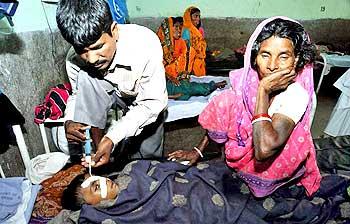 Prayaag Akbar tells the story of 1,000 years of caste-based repression, and of a people's quest for dignity under a democracy that has failed them.
Prayaag Akbar tells the story of 1,000 years of caste-based repression, and of a people's quest for dignity under a democracy that has failed them.
Vilas Ravi Raj, a Musahar, has brought his son Dileep, a shivering six-year old with bandages across his face like a zebra crossing, to the Anugrah Narain Magadh Medical College Hospital. The boy's grandmother has walked with them from the village of Utlibari, around 30 kilometres away, in the same district of Gaya, Bihar.
The father bends over his son, feeding him milk via a syringe and through a tube that goes up the boy's nose. All the beds in the children's ward are filled with similarly suffering children. By their side are parents in tattered clothes and haunted eyes, eyes that are shrouded by confusion and fear each time the nurses describe what is happening to their child.
District health officials have just announced there is an epidemic of meningitis and encephalitis amongst the 30 lakh (3 million) strong Musahar population of Bihar; their living habits bring them in close proximity to pigs and cows, making the children of this community especially susceptible to infectious disease.
This hospital is at the epicentre of the epidemic because Gaya district has the highest concentration of Musahars, though they are found all over the state. Twenty seven children have died in the hospital in just a few days, but members of the medical staff say that the number of children who receive poor or no medical attention far outstrips this number. This is the third year in a row that a meningitis epidemic has been declared in the district.
The Musahars are one of the most deprived communities in India. They were given Maha-Dalit status by the Bihar government some years ago, testament to the abject penury in which most live. They are perhaps best known as rat-eaters (Mus -- mouse; ahar -- eater), a title many in the community are keen to live down, though the tradition remains. Even so, in the villages I visited, the villagers refused repeatedly to hunt rats for the cameras of the freelance photographer who accompanied me (in one ridiculous interlude, he offered the children ten rupees for every rat they caught. They still refused.)
And this is one of the main problems the community faces; as the dominant caste groups in the area and a compliant, sensation-seeking media continue to frame the Musahars' existence through practices like rat-eating, their perilous standards of living can continue to be justified as those deserved by a 'subhuman' community.
Try this for a paradox. Dwarako Sundari is a 68-year old Sindhi gentleman who crossed the border at Partition. In his twenties he was entrusted by Acharya Vinobha Bhave to come to Bodhgaya and build an ashram where Musahirs could be educated and fed. He has been running his school for more than 30 years with no government support, reliant on the kindness of people who travel to Buddhism's holiest place. He received the Jamnalal Bajaj Award for Social Work in 1992, but otherwise there have been few public plaudits. Almost all the educated Musahars in the area have studied in his school, including the aspiring politician Biswas Manjhi, who is hoping for a Rashtriya Janata Dal Vidhan Sabha nomination. He tells me: "Dwarakoji is akin to a saint. He has done so much for us."
It is shocking, then, to learn Dwarakoji's views on these people: "After much thought, I have realised the Musahars are a sub-human community. Jayprakash Narayan once visited my ashram and he said this exact thing to me. Now, years later, I have to agree. I have seen students of mine throw their parents out of the house once they cannot earn anymore, saying they need to feed their children. Women complain to me because their husbands refuse to acknowledge their marital contract. Other families desert their children. Is this the way human beings live?"
When I point out to him that the practices he has listed are prevalent in other communities -- could even be considered common practice in countries like the United States -- he brushes my objections aside. Once again the problem that faces these people is illustrated. Dwarakoji has done as much for Musahar children as perhaps anyone in the world, and when he speaks of the children you can sense his abiding affection. Yet, after 30 years of interacting with the community there is a sharp delineation, a need to see people with such strange and objectionable habits as something quite different from himself.
About 15 minutes drive from the town of Bodhgaya, where the Enlightened One has ensured hundreds of tonsured Japanese and European tourists sit drinking imported Lapsang Souchong (Chinese black tea), there is the village of Parariya, a dot in the hinterland of 300 homes and 1,200 people.
To reach this village you must walk through an ankle-deep swamp until you arrive at a cluster of tiny mud huts. Like every village in India, living arrangements are segmented sharply along the lines of caste: in the distance are the houses of the Yadavs and further along are the Paswans (both of whom are considered upper-caste Dalits and have enjoyed years of patronage under leaders like Lalu Prasad Yadav and Ram Vilas Paswan).
The biggest houses belong to the Thakurs, the landowners of the area, though I am told there is a smattering of Muslim families who have their own conclave.
The Musahar huts are the simplest, reflective of their status within the village hierarchy. Each hut has two windowless rooms, a small open-air courtyard that is used as a kitchen and a roof of thatched hay. The doors and ceilings are built so low you must bend at the waist to enter the room. It is clear that a Musahar roof cannot be higher than a Yadav roof, and so on up the chain.
Kuleshar Manji and his wife Sudama Devi have been married for 30 years. They have five children, four of whom scamper in and out of the house like the mice running around on the floor. They are landowners: "humraa paanch gaj". Though this is not common in the community, this is one of the few areas in Bihar with strong Musahar politicians, and some years ago a land redistribution scheme was implemented that gave each family in the surrounding villages a parcel of land.
But in the village, land without water is like no land at all. The Musahars have the smallest freehold plots of the worst land. Manji and his wife still spend the majority of the agricultural season cultivating the plots of Yadav families.
The Yadav landowners pay each Musahar man Rs 15 for a day's work, while every Musahar woman receives just 2.5 kilos of unrefined wheat, no money. Kuleshar Manji says, "There is no irrigation, so we can't water any of the crops on our land. But the government put in pumps and pipes for the areas where the upper-castes have their land. If we don't work on their land we won't have anything at all."
This works out to around Rs 500 a month during the agricultural season. Manji and Sudama Devi are lucky because their oldest son is working as construction labour in Bhutan, from where he sends Rs 500 a month. "Now with Rs 1,000 we are more comfortable. Three of my children are in school. But most families here don't have anyone to send money. If we had to get by on just the wages I am paid to cultivate the Yadav farms we would be in trouble."
Both husband and wife agree that NREGS (National Rural Employment Guarantee Scheme) has been a huge boon during the difficult non-agricultural season, when the steady daily payment of Rs 80 comes as a massive windfall. The Bihar government has one of the best records of implementing this scheme.
But such poverty can only breed discontent. Many young men from the lowest caste groups in each village have taken up cause with the Naxalites, disillusioned by the unchanging patterning of society.
One former Naxal, a young Musahar who studied in Dwarako Sundari's school and is now a businessman in Bodhgaya, explains: "A lot of the villages here are named after Naxal heroes. People get tired of waiting for change. I drifted in and out of camps since I was 15. We used to hold tribunals here, because the villagers were tired of going to the corrupt courts."
The Naxalite problem affects even the least political villagers, because state functionaries now have a ready-made excuse for not doing their jobs. The former Naxal continues, "while I was growing up, the schools did not have teachers, no health officials would ever come to these areas. They all said the Naxals made it too dangerous for them to work. It is the same now."
Bodhgaya is jammed with tourists from all over the world. The Bihar government has built a shiny, metalled road from Patna to this small town. An international airport has been built at Gaya, so Buddha tourists can pop in and out without seeing the rest of India. But with so much spending allocated to ease the journey of foreigners, what remains for the people of this area? None of the tourism money trickles down to the poorest people of this district, of which the Musahars are only one community.
As the Buddha once left the grounds of his palace in Kapilavastu and found nothing but disease and desolation, leave the city limits of Bodhgaya and you enter a poverty-stricken wasteland.
It is only the very richest people of Parariya, the Thakurs, who own motorbikes, so they do not have to trudge through the swamp that separates the village from the main road. In these villages, the difference between those who own motorbikes and those who don't is not a simple one; it tells the story of a 1,000 years of caste-based repression, and of a people's quest for dignity under a democracy that has failed them.
Image: Vilas Ravi Raj feeds his son Dileep with a syringe as his grandmother looks on
Courtesy: Covert Magazine






 © 2025
© 2025